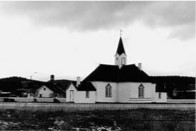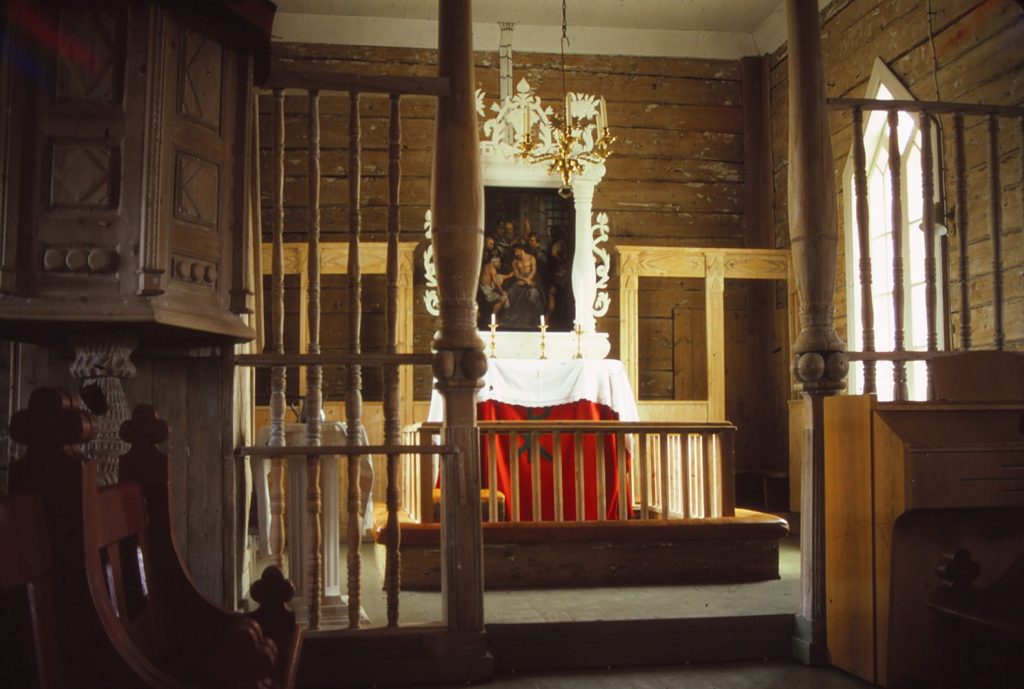Kárášjoga boares girku
Karasjok Old Church
Forfatter/Čállin/Author: Arvid Petterson
Text in English, see below
-

Den gamle kirka i Karasjok ble bygd i 1807. Den overlevde krigen og er Finnmarks eldste kirkebygg. Vi ser litt av den nye kirka på nordsiden av elva 1807 huksejuvvui Kárášjoga boares girku. Dat cevzzii soađi ja lea boarráseamos girkovisti olles Finnmárkkus. Govas oidno maid ođđa girku oasáš, mii lea davábealde eanu.
Karasjok Old Church was built in 1807. It survived the war and is Finnmark’s oldest church building. We can see a bit of the new church on the north side of the river.
Foto/govva/photo: AP 1980
I en reiseskildring fra 1827 er stedet Karasjok og kirka beskrevet:
Karasjok har en riktig vakker beliggenhet på en stor flate som gjennomstrømmes av elva Kárášjohka. Elva svinger seg, slik at stedet ligger på en halvøy. (…) En liten, pen kirke framhever seg fordelaktig mellom beboernes hus og høyhesjer og fjellsamenes stabbur…
Den gamle kirka i Karasjok ble bygd i 1807. Da de tyske styrkene trakk seg tilbake fra frontene i Russland, brukte de den brente jords taktikk. Kirka ble ikke brent og var den eneste bygningen som sto igjen på stedet i november 1944. Kirkas grunnplan er korsformet, men i 1858 fikk den et sakristi som et tilbygg. Den hadde tidligere tjærebrente vegger og små vinduer, men fikk det året høye, spisse vinduer og hvitmalt, liggende panel. Kirka hadde et kuppelformet tårn i empirestil, som i 1902 ble bygd slik vi ser det i dag. Innvendig er kirka nesten slik den var da den ble bygd, med en umalt, sekskantet prekestol med utskårne geometriske figurer og søyle. Korskillet har dreide pilarer og en buet åpning med utskårne løver ved kongemonogrammet til Christian 7. Altertavla viser Kristi tornekroning, og den hvitmalte ramma består av balusterformete søyler og en overliggende arkitrav dekorert med planteornamenter. Gjennom mer enn 200 år har kirka hatt en historisk tilknytning til området. Det var bare et fåtall innbyggere i kommunen som fulgte ordren om tvangsevakuering høsten 1944. Etter at den tyske okkupasjonen var over, flyttet folk tilbake og begynte en provisorisk gjenreisning. Kirka var sentral. Lærer Anna Mørk tok kirka i bruk som bolig, og hun fortalte senere at kirka var delt inn i soner, for mennesker og dyr, for sykestue og fødeavdeling, handel og varelager.
Den 1. mai 1945 skulle 30 soldater fra Rikspolititroppen som var kommet fra Sverige, lære å uskadeliggjøre miner. En stridsvognmine gikk av og til sammen 22 soldater mistet livet. To leger og en sykepleier hoppet ut fra fly og reddet de som var livstruende skadet. Kirka var da omgjort til operasjonssal og sykehus.
Den gamle kirka er Finnmarks eldste lutherske kirkebygg. Bare det lille ortodokse kapellet i Neiden er eldre. Kirka har 140 sitteplasser og etter at kommunesenteret fikk en større befolkning, ble den for liten. I 1974 sto den nye kirka ferdig på nordsiden av elva. Den har plass til 500 mennesker. Kirka ble i 2000 offentlig fredet.
Kilder:
Keilhau, H.M.: Reise i Øst- og Vest-Finmarken, 1831
-

Karasjok gamle kirke. Interiør.
Kárášjoga boares girku siskkobealde.
Interior photo of Karasjok Old Church.
Foto/Govva/Photo: AP
1827 mátkemuitalusas lea Kárášjohka ja girku govviduvvon ná:
Kárášjohka lea hui čáppa báikkis. Stuora jalges eatnamis man čađa golgá Kárášjohka. Johka mohkkasaddá. ja čoahkkebáiki lea njárggas (…) Unna čáppa girkoš ceaggá vuohkkasit viesuid, lajuid ja badjeolbmuid áittiid guovdu.
(sitáhtta lea jorgaluvvon) Kárášjoga boares girku huksejuvvui 1807:s. Go duiskkalaččat geassádedje soahtešiljuin Ruoššas 1944 čavčča, de sii geavahedje taktihka eatnama boaldin. Girku eai boaldán, ja dat lei áidna visti guovllus mii bázii ceaggát. Girku lea hábmejuvvon dego ruossa, muhto liigeoassi, sakristiija, huksejuvvui 1885:s. Ovdal ledje das bihkkaduvvon seainnit ja unna lásežat, muhto lasi huksema oktavuođas oaččui vealufielluid mat ledje vielgadin málejuvvon ja alla čohka lásiid. Girkus lei jorba empiremállet doardna, man rievdadedje dálá hápmái 1902:s.
Siskkobeale lea girku measta justte dakkár go lei dalle go huksejuvvui. Sárdnestuollu lea máletkeahttá. Dat lea guđačiegat, masa leat hábmejuvvon geometralaš govat ja stoalpu. Dat mii earuha searvegotti oasi ja báhpa ja lávluid oasi gohčoduvvo korskille. Das leat jorbejuvvon stoalpput ja dávgi mas muoras hábmejuvvon ledjonat Christian 7 gonagas monogramma lahka. Áltártávvala motiiva lea bastilislátnjákruvdnun. Rámma lea vielgadin málejuvvon, das leat baluster hámat stoalpput ja arkitav-holga mas leat šaddohearvvat.
Girkus lea badjel 200 jagi leamašan dehálaš historjjálaš mearkkašupmi guovllus. Ledje dušše moattis gieldda ássiin geat doahttaledje bággoeváhkkui man 1944:s dáhtto. Go soahti nogai, fárreje olbmot ruovttoluotta ja álggahedje ođđasishuksema. Girku lei guovddážis. Oahpaheaddji Anna Mørk geavahišgođii girku orrumii, ja son muitalii maŋŋá ahte sii ledje juohkán girku osiide. Ledje oasit olbmuide ja elliide, buhcciidruktui ja mánáriegádahttimii, gávppašeapmái ja gálvovurkemii.
30 politiijakompaniija soalddáha bohte Ruoŧas oahppat movt miinnaid čorget sihkkaris vugiin. Miessemánu 1. beaivvi 1945:s bávkkehii vovdnamiidna ja oktiibuot 22 soalddáha dušše. Girdis njuikeje seaivunsujiin 2 doaktára ja 1 buohccidivššár, ja sii gádjo sin geat ledje garrasit roasmmehuvvan. Dalle geavahedje girku operašuvdnalatnjan ja buohcciviessun.
Boares girku lea Finnmárkku boarráseamos luhteránalaš girku. Lea dušše Njávdáma ortodoksa kapealla mii lea boarrásit. Girkus leat 140 čohkkánsaji ja go giliguovddáš stuorui de gárttai girku beare unnin. Ođđa girku davábealde joga gárvánii 1907:s. Dohko čáhket 500 olbmo.
Almmolaš mearrádusain suddjejuvvui boares girku 2000:s.
Gáldut:
Keilhau, H.M.: Reise i Øst- og Vest-Finmarken, 1831
Karasjok and its church are described in a travelogue from 1827:
Karasjok has a really beautiful situation on a large plain, through which the River Karasjohka flows. The river bends so that the site is on a peninsula. (…) A pretty little church is favourably placed between residential houses, hayracks and a mountain Sami storehouse…
Karasjok Old Church was built in 1807. When the German forces withdrew from the Russian front in the autumn of 1944, they employed scorched-earth tactics. The church was not burned down; it was the only building left standing at the site. The church’s ground plan is cross-shaped, but in 1858 it was extended with a sacristy. Previously it had tarred walls and small windows, but it was thereafter given drop siding, a coat of white paint and tall, pointed windows. The church had an Empire-style domed tower, which was remodelled in 1902 to give us the steeple we see today. Inside, the church is almost as it was at the time it was built, with an unpainted hexagonal pulpit with carved geometric figures and column. The chancel screen has turned pillars and a curved opening with carved lions bearing the royal monogram of Christian VII. The altarpiece shows Christ’s crown of thorns, and the white painted frame consists of balustrade columns and an overhead architrave decorated with botanical themes.
The church has had a historical connection with the area for more than 200 years. Only a few of the municipality’s residents obeyed the order of forced evacuation in the autumn of 1944. Once the German occupation was over, people returned and began a temporary rebuilding. The church played a central part. Teacher Anna Mørk used the church as a residence, and she later told how the church was divided into zones – for humans and animals, for a sickroom and maternity room, and for trade and warehousing.
On 1 May 1945, 30 soldiers from the Norwegian police troop arrived from Sweden. They were to learn how to disarm land mines. An antitank mine went off and over 22 soldiers lost their lives. Two doctors and a nurse parachuted from planes and rescued those suffering from life-threatening injuries. At that point, the church was turned into an operating theatre and hospital.
The old church is Finnmark’s oldest Lutheran church building. Only the little orthodox chapel in Neiden is older. The church has 140 seats, which was not enough once the municipality’s population started to grow. The new church on the north side of the river was completed in 1974. It seats up to 500 people.
The old church became a listed building in 2000.
Sources:
Keilhau, H.M.: Reise i Øst- og Vest-Finmarken (English: Travel in East and West Finnmark), 1831.
